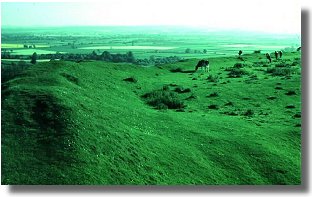Shewy
& Ian's English Life
|
CADBURY CASTLE Arthur's Camelot or Dumnonian Capital?
The Tradition: The stories of King Arthur at the hillfort of South Cadbury, near the villages of Queen and West Camel, are actually not particularly old. The travelling historian, John Leland, first recorded the association in 1542: "Right at the South end of South Cadbury Church stands Camelot. This was once a noted town or castle, set on a real peak of a hill, and with marvellously strong natural defences..... Roman coins of gold, silver and copper have been turned up in large quantities during ploughing there, and also in the fields at the foot of the hill, especially on the East side. Many other antiquities have also been found, including at Camelot, within memory, a silver horseshoe. The only information local people can offer is that they have heard that Arthur frequently came to Camelot." |
 |
It is a pleasant stroll around the ramparts, offering splendid panoramic views of the Somerset countryside extending to Glastonbury and beyond. Admission is free but please park in the lay-by provided. |
|
|
Visitors please :-
|
||